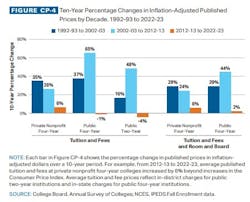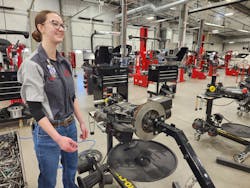Trade school vs. college: Experts, students weigh in
For 44 million Americans, time has run out. The COVID-19 student loan moratorium ended on Aug. 31, which means payments on a collective $1.6 trillion will resume in October. Interest on loans started back up Sept. 1.
While this affects approximately 13% of the population, that does not include Morgan Woodtke, a diagnostic technician at Allegiance Trucks in Torrington, Connecticut. Her education comprised a 15-month stint at Lincoln Technical Institute's diesel program that cost around $30,000 in total, even less since Woodtke helped fund her education with $12,000 in grants.
On average, a diesel tech with four years of experience like Woodke makes $26.14/hour, according to the U.S. Bureau of Labor Statistics (BLS). This is already better than the average $21.32/hour that the BLS estimates someone with only a high-school degree makes, even if a bit under the average rate of $35.80 a person with a Bachelor’s degree can earn. But in Woodtke’s favor, Allegiance Trucks has an hourly hiring rate of $18-$40 per hour, making it likely that Woodtke’s pay, with enough experience under her belt, could eventually be double the national diesel technician average.
Read more: Fullbay's 2023 State of Heavy-Duty Repair shows shop revenue recovery, increased technician payWith the industry starving for technicians, it’s no wonder that that technician pay rates are likely to continue rising, a fact that Woodtke was also able to observe as both her father and brother have found success as mechanics.
“My older brother actually graduated from the same program that I did,” the 24-year-old said. “He was super successful with it, so I knew that I had a good chance, too.”
Even knowing that her skills would be high in demand upon graduation, cost still had a definite impact on where Woodtke chose to study. However, when she would pay for her education was just as important to her as how much the bill would be.
“I didn't have to start paying until six months after I graduated from Lincoln Tech, whereas at a standard college, you have to pay immediately and by semester,” she explained. “I think that sets people up to succeed because it gives you time to finish school, get a job, and get your feet on the ground before you have that extra bill.”
Now, like Woodtke, more people are discovering the benefits of trade school over four-year degrees.
“The biggest benefit to attending a trade school over a four-year university is the time spent in school,” said Jim Mathis, president and owner of WyoTech, an automotive, diesel, and collision trade school based in Laramie, Wyoming. “Students who attend a trade school are often able to graduate and enter the workforce in half the time or less of a tradition four-year university, leading to them having less school debt and giving them the ability to start earning a living sooner.”
The difference between four-year colleges and trade schools is most apparent in two areas: cost and job prospects. This is apparent when comparing the costs and job prospects of traditional institutions with those from WyoTech; Lincoln Tech, a trade school for various industries; ADTC, a recruitment and training program for diesel technicians; and New Village Institute, a Blairsville, Pennsylvania-based diesel and automotive training school.
Cost
According to the 2022 Trends in College Pricing and Student Aid Report from CollegeBoard, tuition, fees, room, and board cost $53,430 per year at a private, nonprofit, four-year college, and $23,250 at a public four-year school. Even at the lower-cost institution, this makes the price tag for a full four years of education roughly $93,000, if not more including the costs of books and supplies.
In comparison, WyoTech’s core diesel technology program and specialty advanced diesel program can be completed in an average of nine months, with the school’s website stating that the costs for tuition, the application fee, books, equipment, supplies, and tools during those months adds up to $32,000 in total. Even with the addition of room and board and no help from grants, scholarships, or financial aid, WyoTech’s net price calculator estimated that the cost of the diesel program would still be about $37,560.
At Lincoln Tech, tuition costs can vary by the campus location and the programs can run from 9-18 months, but the diesel and truck service courses generally cost between $35,000-$41,000; and NVI offers its six-month program for $25,000. But some students don’t even pay that much.
“I didn’t pay a single cent to go to school there,” said Aaron Saylor, a diesel technician at a Transteck, Inc. Freightliner Western Star location in Altoona, Pennsylvania, and a 2023 NVI graduate. Like Woodtke, Saylor leveraged NVI’s grant program for his tuition, a feat that ThinkImpact found only 1.5% of students achieve.
Read more: WyoTech rises to meet increasing technician demand
But while fully covering a student’s tuition might be rare in traditional academia, at ADTC, formerly known as American Diesel Training Centers, this is the case for all of their students. The company connects prospective technicians with employers, and then the employer bankrolls the technician's education, including travel expenses, room, and board.
“We don't work with companies unless they say, ‘I will completely sponsor these folks,’” said Tim Spurlock, CEO and co-founder, ADTC.
In return, ADTC offers a six-week diesel technician training program and a five-week collision training course.
“[ADTC’s students] don’t need two years at a community college,” Spurlock asserted. “They don't even need 13-18 months at an expensive, $40-50,000 technical school. If you take someone who will show up, has good attitude, is willing to learn, and works well with others, that's 95% of the battle.”
Job prospects
Another benefit to trade schools is that many compress the time spent in school and searching for a job after graduation. For ADTC, no student begins the program without being employed and onboarded on the very first day, even before their technical training begins.
This compressed timeframe also applies to longer training programs like those at WyoTech or Lincoln Tech, both of which provide career development opportunities for their students. Lincoln Tech has a Career Development Center which helps line students up with jobs while they study, and WyoTech hosts a quarterly career fair that often hosts companies such as Penske Truck Leasing, Travel Centers of America, and Peterbilt.
“If a student wants a job, they could leave [the career fair] with 10 job offers just in those two days,” Mathis said in a 2022 interview. “That’s how intense and how needed our students and other tradespeople are.”
Both Woodtke and Jillian Proell experienced this need for skilled technicians, even before graduation. Proell is a 19-year-old diesel student at WyoTech from Fairbanks, Alaska, and even though Proell is still completing her coursework, she knows she’ll be employed once she graduates.
“I have a job lined up when I get done with school,” Proell said. “I'm going to go back home to work at Papé Kenworth.”
Proell first worked at the truck dealer before she went to WyoTech to earn her degree and was invited to return after school. She’ll work with them for two years and round out her education with on-the-job training, which will open further doors for her career.
Lincoln Tech also helped connect Woodtke with a job while she was at school. With the help of a friend and Lincoln Tech’s Career Development center, she began working with Allegiance Trucks three months into her program.
“In my opinion, that's the best way to go because then you're getting real-world experience,” Woodtke noted. “Then when you graduate, you can start at a higher level than you would just being in school.”
Even for technical students who don’t line up a job while in school, the market is their oyster upon graduation. If you search for ‘diesel technician’ jobs on LinkedIn, over 6,000 results appear within seconds, and nearly 28,000 on Indeed.
Saylor leveraged Indeed’s platform to land his role at Transteck, first finding the company while he was at NVI and then following up after he graduated.
“About a week after I was done with school, I got an interview with them,” the 21-year-old tech explained. “Then I took a few weeks off and started working.”
The rise of trade schools
The benefits of a trade school education have resulted in growing enrollment numbers for vocational schools, while four-year institution enrollment has declined in recent years.
Since fall 2011, CollegeBoard found that total postsecondary enrollment had fallen by about 10%, from 20.9 million to 18.9 million in the fall of 2020.
In contrast, Data USA found that enrollment in many trade schools has risen or remained largely consistent over the past few years, with WyoTech’s full-time enrollment growing from 76 students in 2018 to 1,484 in 2021, and Lincoln Tech’s Pennsylvania location consistently hosting between 450-600 students during the same period. Even at NVI, which has only been open for about a year, Gary Beman, NVI CEO stated that they were confident that they could reach their maximum enrollment “in the next few years.”
In the meantime, WyoTech's explosive growth led the school to complete a 90,000 sq.-ft. expansion to its Laramie campus in December 2022. Mathis reported that the school's population had grown by 6,817% since 2018.
“We have a goal of having 10,000 students by 2030,” said Cindy Barlow, WyoTech’s director of industry outreach at the expansion’s grand opening, a goal which the school has facilitated by purchasing another 72 acres of land across the street from WyoTech for further development.
While millions of Americans are once again shouldering the weight of student debt, technical schools are offering the next generation of learners another path that focuses on affordability and immediate career growth. And if the numbers are any indication, they’re taking it.
“As universities continue to ask for sky-rocketing tuition prices with paychecks that don’t begin to offer a fair return on investment, short-term, focused programs will continue to excel in this country,” Mathis predicted.
About the Author

Alex Keenan
Alex Keenan is an Associate Editor for Fleet Maintenance magazine. She has written on a variety of topics for the past several years and recently joined the transportation industry, reviewing content covering technician challenges and breaking industry news. She holds a bachelor's degree in English from Colorado State University in Fort Collins, Colorado.


